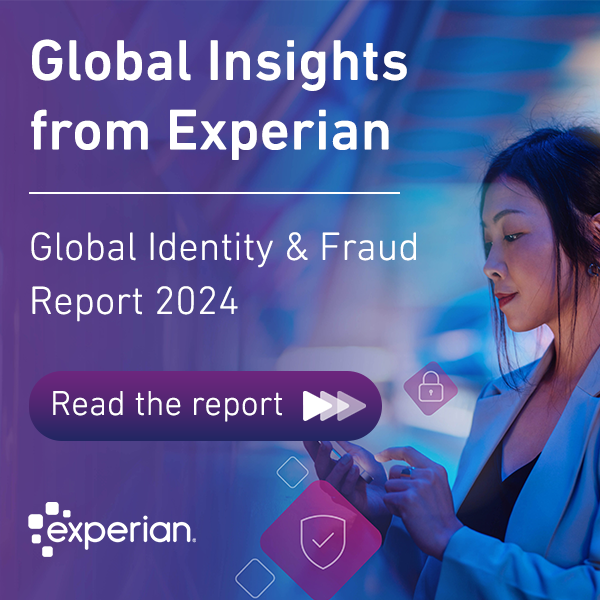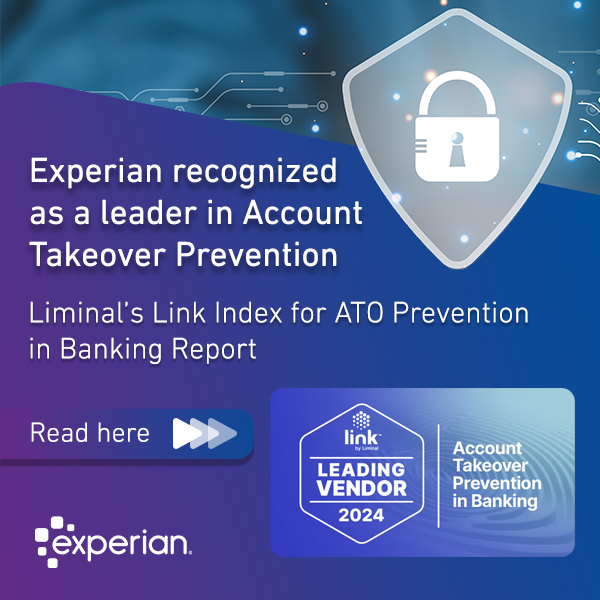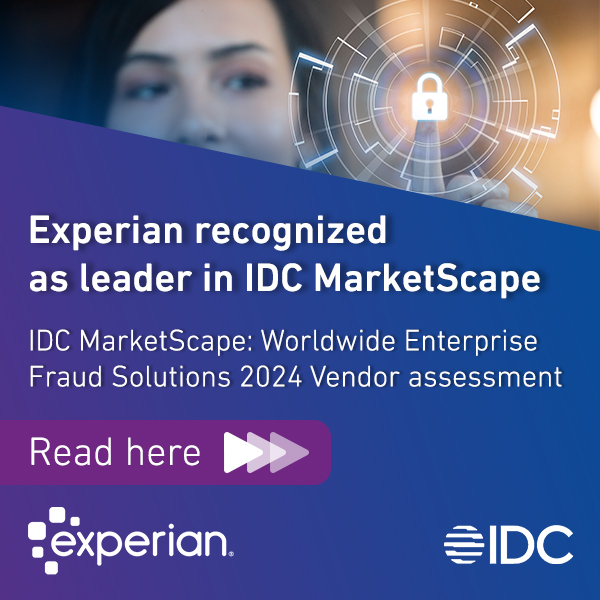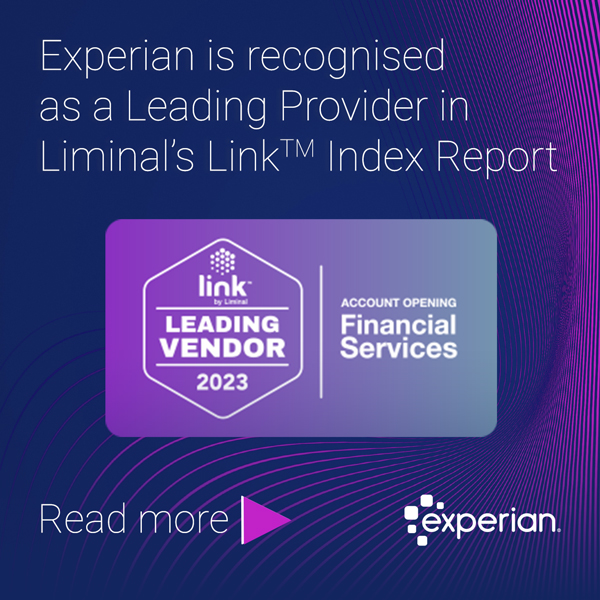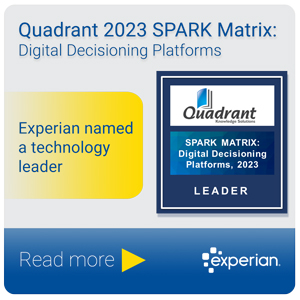Tag: Identity & Fraud

Don't miss out on the top January headlines, including the latest coverage from our global experts, including the digital identity landscape, impacts of pandemic fatigue, protecting users and their experience, Covid-19 impacts on businesses in India, and consumers' digital experience expectations. Experian selected as leading provider of digital identity This MarTech Series article looks at Juniper Research's Digital Identity: Technology Evolution, Regulatory Landscape & Forecasts 2020-2025 report. David Britton, Vice President of Industry Solutions, offers his perspective on providing both convenience and security. In 2021, loyalty shouldn't be assumed Destination CRM covers findings of the recent Experian Global Insights report, which indicates that consumers might not be as patient with businesses for much longer. The impact of "pandemic fatigue" translates to an end in consumer acceptance of the pandemic as an excuse for poor service. Establishing and protecting user identity in a digital world Eric Haller, Executive Vice President & General Manager, Identity, Fraud & DataLabs, speaks to the rise of digital and the impact on the need to be able to identify an individual. Relying on technology to help deliver a good user experience is key to avoiding too much friction in the process. 99 percent of businesses in India implement digital online strategy to recognise customers; highest in APAC: Experian Report#TradeTalks: Increasing consumer demands and expectations Business Standard looks at recent global research findings on consumer and business economic outlooks, financial well-being, online behavior, and more. Most prominently, the vast majority of Indian businesses implementing strategies to recognize customers across platforms. The top three reasons people abandon online transactions In this Global FinTech Series article, Chris Fletcher, SVP Decision Management & Cloud Services, explores the current environment of online transaction explosion and what it means for businesses to accommodate this lasting preference for digital. It will be key for each transaction to align the need for security with the right level of friction to the consumer. Stay in the know with our latest insights:

Get the latest from our global experts with these top December headlines, including meeting the demand for digital, increasing consumer expectations, women leading artificial intelligence, and protecting against fraudsters over the holiday shopping season. Investment priorities to meet consumer demand for digital banking In this BAI Banking article, Chris Fletcher, SVP Decision Management & Cloud Services, explores the investment required of financial institutions to transform their use of data and analytics and deliver on credit risk strategies. What’s the proper path for better payments? In context to consumers’ digital expectations post-Covid-19, Progressive Grocer considers the future of payments in food retail and beyond – with contactless payment options already rolling out at a large drug store chain. Wisdom from the women leading the AI industry, with Laura Stoddart of Experian Authority Magazine speaks with Laura Stoddart, Data Scientist, about her career path, her experiences working on ethical AI and using emerging datasets to evaluate risk as well as her thoughts on the future of this industry. #TradeTalks: Increasing consumer demands and expectations Steve Wagner, Global Managing Director of Decision Analytics, joins Nasdaq’s Jill Malandrino to discuss recent research findings on increasing consumer demands and digital expectations, and ongoing considerations for a post-Covid-19 world. A holiday season like no other: What to know to guard your company against fraud Itay Levy, Forbes Councils member and CEO and Co-Founder of Identiq, provides his perspective on the increased preference for online shopping and the need to strike the right balance between customer experience and efforts to mitigate fraud. Stay in the know with our latest insights:

Over the past fifteen years, identity-related fraud has evolved towards more automation, in the form of scripted attacks and bot attacks, as well as more sophisticated phishing attacks. Credential harvesting was the most prevalent form of fraud in the early 2000s, while recently, the global coronavirus pandemic has accelerated sophisticated attacks such as account opening fraud and account takeover fraud. This infographic showcases the evolution of fraud from 2005 to 2020, offering a complete view of different types of fraud and the most effective identity management and fraud prevention solutions to keep ahead of fraudsters over time: Related stories: Fraud trends during a very pandemic holiday Getting to grips with the shifting fraud landscape What your customers say about opening new accounts online during Covid-19

The relationship with artificial intelligence may have started with robots but its integration into the way people interact with the world today looks very different. AI is in our pockets, our homes, our workplaces, and its pay-off is being realized across many industries, including financial services, e-commerce, telecommunications, streaming services, insurance companies, and more. Though some people and businesses still have reservations about its use. In the next article in our “Game Changers: Women in AI” series, we examine the artificial intelligence debate with arguments against and for its use in our everyday lives, and how it can bring real value to our interactions with businesses – whether it’s preventing fraud, increasing financial accessibility, enhancing the digital experience or supporting public initiatives to prevent the spread of Covid-19. Q: What is your view on criticism of AI or arguments against its use? He: "AI is already all around us and sometimes people don’t even realize it. For example, smart devices remember your preferences, try to understand your behaviors, and help you with reminders, goals, or some other alert. For some, this can feel a little bit scary, like they are collecting information and profiling you. But really, AI is helping people by using large amounts of data to train models and find patterns in the information to solve complicated problems." Kazmi: "Since AI is still so new, every time a product or a change in experience through AI is introduced, there are bound to be reluctancy in adoption and initial failures which lead to opposition. But, to establish the final best product possible, we need understanding between AI research teams and business stakeholders. Take the example of Elon Musk. He has come up with SpaceX and Tesla, but there have been so many failures in their development. Still, the entire world was looking up to these ventures, because these products are something that's going to bring huge positive change." Kung: "People need to keep in mind that AI, and all this data science technology, are just tools to help us. It's not that a machine will replace someone. I’ve heard a lot of people saying, "You create things automatically, and machines will replace our job." That’s not how it is. The truth is, we are creating these kinds of things to help us. It improves our lives by saving our time to focus on other useful things that a machine can’t do." Peters: "It’s helpful to consider what got us here. Years back, people would ask, “Are you ready for big data? Do you have big data?” What we found was that as more data was available, even when managed effectively, we needed ways to consume it and to garner insights from it. This underlying piece drove the need for AI and machine learning. Working with these technologies is critical to harnessing the power of data for what we do, to apply these concepts to fuel significant problems, like stopping fraud." Stoddart: "The topic of bias in AI creeps up in the news. If an algorithm is not checked properly, it could mean a portion of the population isn’t reflected. This stems from assumptions inherent in people. If those writing the code are not diverse, you likely miss out on representing whole groups of people in the wider society. This issue of bias emphasizes the importance of team diversity, of driving success by having opinions challenged and ensuring representation across diverse groups." Q: Is there anything you would like to share that could help alleviate fears and show the public that AI is beneficial? He: "It will lessen fears if we can help people realize there needs to be humans involved. To understand the data, to understand human behavior, everything is about the observation and how you interpret it. It also helps to share the benefits people will realize. For example, AI can improve consumer experiences — such as when filling out an application. It can build bridges between different types of data to supplement the details provided. This reduces the friction felt by the applicant by simplifying the inputs required, which is very useful on wearables and mobile devices." Kazmi: "AI can change the world. If you just look around, data science is part of everything nowadays. And, there's often a solution you benefit from but are not even aware that it has AI embedded in it in some way. It’s important to encourage understanding and acceptance and highlight all the good work that people are doing in this industry. We need to acknowledge and encourage endeavors to further these contributions and progress in the AI industry." Kung: "My concern is that people think “Oh, you just put something in the machine and the machine will tell you what to do." It's not like that. People need to realize a human must analyze the results – what it gives you and what you see. It needs to make sense for their business. The machine will not know what you’re analyzing. It will just run the algorithms that you put in it and it gives you a number. It’s up to people to analyze it." Peters: "Whenever you go into a new and somewhat unexplored area, there will always be different aspects to consider. As researchers, innovators, and developers, we need to be aware of inherent risks and keep an eye on the ethical aspects of technology. This focus helps ensure the thoughtful progression of AI, creating the right guardrails to thwart fraudsters and ill-intentioned individuals and equality by being “consciously unbiased” in the models and systems we are building." Stoddart: "I mentioned the need for diversity to prevent bias. I’m proud to be contributing to a project called “fairness.” It’s about tackling bias in models – using AI to help treat everyone fairly. Our work has enabled people to drill down and properly check attributes to ensure that decisions are fair and not discriminating against a certain group. If it’s not fair, it provides the opportunity to fix it. I believe this will be a really important tool going forward." Q: What examples can you share for how AI can bring goodness to the world? He: "At the very beginning of our latest initiative, we were thinking, “how will this development and innovation help the world?” It was hard to answer until we created different use cases. Currently, we have several meaningful results using AI – linking data to identify a person and deliver the best customer experience and helping detect fraudulent applications using fake or synthetic IDs. We also recently developed a heatmap for predicting Covid-19 severity for more than 3,000 counties in the U.S. We’ve made this tool available to assist public researchers as well as government and policymakers." Kazmi: "I am truly satisfied with the work that I have been doing because it's very exciting to find new ways to have a positive impact. From the day I joined Experian, I've been part of a project called financial inclusion, leading the data science part of it. We are helping people and entities stuck at the lowest level of the financial ladder. This is the beauty of data science, helping consumers and small entities access credit and come out of a vicious cycle, to move up financially, leading to the overall growth of the financially weaker sections of society." Kung: "Within my area of focus, financial services, we can help make life easier and help get things done faster. The important thing is time-saving because we need to get things done quicker. For example, sometimes people try to secure credit and the bank takes too long to give an answer. Or, with a mortgage, there is a lot of paperwork needed. We can use an AI tool to help analyze this paperwork faster, which helps the customer who needs the loan get their home faster." Peters: "Some of the ways that it can bring goodness to the world is where we are just limited by the scale or the speed that we want to move when solving problems based on huge amounts of data, especially in real-time. Where AI can help predict next best actions or best outcomes in a way that usually would require a lot of research or photographic memory. Very relevant today, this applies well to the medical domain, but there are so many areas AI can help us better consume data at our fingertips and predict new innovative areas to explore." Stoddart: "In addition to the fairness project I mentioned, I also use my data science skills volunteering with a social enterprise, helping them obtain the insights they need to determine what food and supplies are most needed at food banks. The insight allows them to prioritize what items to buy in bulk with monetary donations from the public. Usually, food banks are really separated in the UK, so this is a new approach benefitting from advanced technologies." Related stories: Game changers: Women in artificial intelligence (part 1) Impact of technology on changing business operations Forbes: Are we comfortable with machines having the final say? Yi He Yi He works as a data scientist in the Experian NA DataLab. She is dedicated to using machine learning and AI to extract information from large amounts of data to identify, understand and help people, and prevent fraud. She aims to bridge online and offline worlds by linking identity data from these unique sources. With a focus on minimizing friction to customers, Yi’s work helps organizations identify synthetic identities to avoid fraudulent applications. Recently, she contributed to a Covid Outlook & Response Evaluator (CORE) Model – a “heat map” of geographic populations across the U.S. most susceptible to severe cases of Covid-19. Deeba Kazmi In her role as a data scientist at the Experian APAC DataLab, Deeba Kazmi is focused on solving business problems with analytics, including the development of consumer and small to medium enterprise credit risk models that leverage alternative data. Deeba is passionately focused on leveraging AI to create solutions that can help address issues faced by developing markets. Most prominently, this work includes her data science leadership contributions to solving a crucial economic and societal problem – financial inclusion. This effort is helping disadvantaged socio-economic consumer groups gain access to vital credit and financial services by leveraging the power of technology to deliver better outcomes. Jennifer Kung Jennifer Kung is an analytics consultant for Serasa Experian Decision Analytics, where she combines her knowledge of financial services with her data analysis expertise. Jennifer aims to harness the power of data through robust, descriptive and predictive analytical solutions to help clients realize the benefits of the massive amounts of data available to them. She recognizes the magnificence in powering discoveries through data analysis and enjoys revealing these capabilities to businesses who can benefit from these robust, yet approachable solutions. Jennifer enjoys knowing that her work helps to simplify and accelerate decisions that consumers rely on at important times in their life. Kathleen Peters Kathleen Peters leads innovation and business strategy for Decision Analytics in North America. As the prior Head of North America Fraud & Identity business, Kathleen is well-recognized as an identity industry innovator, being named a “Top 100 Influencer in Identity” by One World Identity the last two years. As of 2020, Kathleen was named Chief Innovation Officer for Decision Analytics. Kathleen and her team rely on the power of AI to continuously find new ways to solve customer challenges by defining product strategies, new paths to market and investment priorities. Underlying these efforts is a key focus on the ethical use of technology and the need to be consciously unbiased. Laura Stoddart Laura Stoddart is a physicist turned data scientist who works at the Experian DataLab in London. From her first exposure to AI, she recognized how quickly it can have an impact on the world, which has driven her to get and stay involved in the industry – both professionally and personally. Laura’s recent work has focused on ethical AI, having recently contributed to her first paper addressing the removal of bias from models. In addition, she is concentrated on leveraging emerging datasets to evaluate risk. Outside the DataLab, Laura also volunteers her data science skills to good causes such as Bankuet and helps expose others to the world of AI through mentoring.

The artificial intelligence (AI) market is expected to grow 159% by 2025 to $190.61 Billion, according to Markets and Markets, and there’s considerable value for businesses and consumers. In our July global survey of businesses and consumers, we found that 60% of businesses planned to invest in advanced analytics and AI to better support their customers' financial needs during Covid-19. As more businesses adopt AI, processing their vast amounts of data with advanced analytics for automated decisions, human oversight is and will remain key to ensure transparency and explainability. This “human element” in AI was the inspiration for our latest “game changers” series. We recently sat down with five industry experts to get their view on how AI is making the world a better place, and how its use in financial services can be realized. Yi He, Deeba Kazmi, Jennifer Kung, Kathleen Peters, and Laura Stoddart are visionaries and leaders in data science and innovation making a real difference in how advanced technologies are helping consumers and businesses engage more meaningfully. Q: What excites you most about the AI Industry? He: "As AI is more involved in our lives, it provides benefits we couldn’t imagine before – such as using your face to unlock your phone security. With the development of AI and machine learning, we can find patterns in data or in behaviors of people to solve complicated problems. That’s really it; helping people make life easier." Kazmi: "The main thing is that AI is not only transforming the way we live and communicate, it's changing the way almost every industry around the world is going to operate. To positively contribute to this growth, it’s not just that you need to learn and then deliver, but to keep innovating and coming up with new solutions that others learn from." Kung: "The technology improvement excites me. Things are getting easier, giving us more time to focus on what really matters. We usually don’t have time to focus on some of these areas because we are used to doing things manually. Now with AI, we have a machine to do a job that is manual, so we can focus on analysis and improvement." Peters: "What’s most exciting for me are ways AI technology can augment human decisions and innovation, in new directions that we historically run out of horsepower for. And, it can be applied to virtually every industry — the ways that it can better help us leverage big data, robotics, the Internet of Things — there are so many directions we can go with AI." Stoddart: "One of the most exciting things about AI is that people benefit from it every day — using social media, or maps to get to the shops, sometimes without even realizing it. And, if you can create an algorithm that can help somebody get credit who previously couldn't, you can have a real impact on the world that actually changes people's lives for the better." Q: What concerns you most about the AI industry? He: "I think the key things are data security and privacy protection. People are more and more sensitive about their information being used and released, which is understandable, and why opportunities exist to opt-out of information being used or sold to third parties. The key is to offer comfort by building in how to secure the data and protect privacy." Kazmi: "There are pros and cons of everything, especially with a stream of faster evolutions in prominent areas affecting our day-to-day lives. Since it’s still so innovative, when AI is introduced, there’s bound to be reluctance. But, to progress, we need acceptability, encouragement and patience; an understanding between AI research and stakeholders that these developments are going to bring huge positive change." Kung: "My main concern is that we need to keep in mind that AI is just a tool to help us. The machine will not replace humans and it cannot tell you what to do. An algorithm can give you a number based on its design. You need to analyze that result and ensure decisions make sense for your business." Peters: "The more we know and learn about AI, the better we can anticipate potential risk areas. These include the ethical aspects of technology, and striving to be consciously unbiased. As we progress, explainability and other model governance practices will help us stay within the right guardrails and mold the necessary regulations." Stoddart: "Lack of diversity concerns me – both in the boardroom and on the programming side. Decisions that we make in our programming are based on assumptions as human beings and our lived experience. If the people writing the code are not diverse, you’re missing out on whole groups of people in the wider society." Q: Can you share with us the “backstory” of how you decided to pursue this career path? He: "My educational background includes cognitive science, neuroscience, and psychology, and it involved a lot of data analysis and modeling. I wanted to understand how humans behave. In my first job, I did essentially the same work — understanding human behavior from large amounts of data — but to detect fraud. That amazed me and driving my focus today." Kazmi: "My education included subjects around analytics, and had a lot of flavor of data science, predictive modeling, mathematics and statistics. AI was very new at the time. I studied these topics and began to understand how data science is developing, and what's the future of it. I really got excited and interested into it. And once I started my career, there was no looking back." Kung: "As a child, I thought I wanted to be an engineer. Statistics was my second choice. But, I am really glad I had the opportunity to follow this path, because statistics and data analysis are amazing. When I started my course, I was so amazed at how data analysis can help you discover a world. You can do anything with data. I realized that this was my true passion." Peters: "I became interested in AI from the business aspects – working in a big data environment, we really needed machine learning and AI to handle data at scale. When joining Experian in the identity and fraud area, our mission was clear – harnessing the power of one of the largest data assets in the world to make a difference; finding new ways to stop fraud." Stoddart: "I studied physics at university and attained a master's in particle physics. But, during my final year, I started to learn about AI and machine learning. It was inspiring, especially how quickly they can have an impact on the world compared to academic research, which can be over many years. Realizing how quickly it was progressing, I thought it would be really exciting to get involved." Q: Can you tell our audience about the most interesting projects you’re working on now? He: "Recently, I’ve been working on use cases and projects surrounding identity. We have been working to link identity data from various sources – online and offline. Here at Experian, we have information from many sources, across different business areas. This project is providing a platform to link all this data together, which in the past was not very easy to accomplish. With this platform to provide linkages, it provides a 360-degree view of a person and helps provide conclusions such as whether two identities are the same person. To do this, we utilize machine learning techniques and AI. It’s very exciting." Kazmi: "I would like to mention something I'm very proud of, which has been a turning point in the way I look at data science solutions. I have the privilege of playing a prominent role in solving for a crucial economic and societal problem of the world, financial inclusion. This issue has historically blocked growth for financially weak and less established sections of society. I am leading data science as part of the initiative, exploring different sources of information beyond credit history, to increase access to financial products. This is the beauty of data science and how it helps us." Kung: "At Experian, I work in a consulting area, so I advise our customers and show them the power of data. Often, it’s not easy for a client to recognize this power. That’s our job – showing them how data can help their business or their decisions. We developed a credit decisioning model for one client using machine learning. This showed them how powerful it can be to use the data we make available to them. They were so amazed with the results. It was a really great experience." Peters: "The newest aspect of my role is leading innovation and strategy for decision analytics in North America. I am constantly on the watch for opportunities to incubate and try to apply Experian’s data and analytics and AI capabilities to solve new problems. We are looking at the role of identity and how we might apply capabilities in new ways. There is an expansion of needs, especially as the world evolves, and how we’re identified is evolving. So the application of Experian’s differentiated capabilities to new areas and markets is an area of focus of mine that I'm really excited about right now." Stoddart: "One of the most interesting projects I've worked on since joining the lab is around fairness of machine learning algorithms, decision-making. It’s about tackling the bias that can come when you use machine learning in a real world scenario. This happens when an algorithm is not being checked properly and it's discriminating against a certain group. To be part of building this vision about treating everybody fairly is great. Especially to be part of a company that values this effort and recognizes that it's going to be increasingly important going forward." Related stories: What is the right approach to AI and analytics for your business? Four fundamental considerations Maximizing impact from AI investment: 4 pillars of holistic AI Forbes: Are we comfortable with machines having the final say? Yi He Yi He works as a data scientist in the Experian NA DataLab. She is dedicated to using machine learning and AI to extract information from large amounts of data to identify, understand and help people, and prevent fraud. She aims to bridge online and offline worlds by linking identity data from these unique sources. With a focus on minimizing friction to customers, Yi’s work helps organizations identify synthetic identities to avoid fraudulent applications. Recently, she contributed to a Covid Outlook & Response Evaluator (CORE) Model – a “heat map” of geographic populations across the U.S. most susceptible to severe cases of Covid-19. Deeba Kazmi In her role as a data scientist at the Experian APAC DataLab, Deeba Kazmi is focused on solving business problems with analytics, including the development of consumer and small to medium enterprise credit risk models that leverage alternative data. Deeba is passionately focused on leveraging AI to create solutions that can help address issues faced by developing markets. Most prominently, this work includes her data science leadership contributions to solving a crucial economic and societal problem – financial inclusion. This effort is helping disadvantaged socio-economic consumer groups gain access to vital credit and financial services by leveraging the power of technology to deliver better outcomes. Jennifer Kung Jennifer Kung is an analytics consultant for Serasa Experian Decision Analytics, where she combines her knowledge of financial services with her data analysis expertise. Jennifer aims to harness the power of data through robust, descriptive and predictive analytical solutions to help clients realize the benefits of the massive amounts of data available to them. She recognizes the magnificence in powering discoveries through data analysis and enjoys revealing these capabilities to businesses who can benefit from these robust, yet approachable solutions. Jennifer enjoys knowing that her work helps to simplify and accelerate decisions that consumers rely on at important times in their life. Kathleen Peters Kathleen Peters leads innovation and business strategy for Decision Analytics in North America. As the prior Head of North America Fraud & Identity business, Kathleen is well-recognized as an identity industry innovator, being named a “Top 100 Influencer in Identity” by One World Identity the last two years. As of 2020, Kathleen was named Chief Innovation Officer for Decision Analytics. Kathleen and her team rely on the power of AI to continuously find new ways to solve customer challenges by defining product strategies, new paths to market and investment priorities. Underlying these efforts is a key focus on the ethical use of technology and the need to be consciously unbiased. Laura Stoddart Laura Stoddart is a physicist turned data scientist who works at the Experian DataLab in London. From her first exposure to AI, she recognized how quickly it can have an impact on the world, which has driven her to get and stay involved in the industry – both professionally and personally. Laura’s recent work has focused on ethical AI, having recently contributed to her first paper addressing the removal of bias from models. In addition, she is concentrated on leveraging emerging datasets to evaluate risk. Outside the DataLab, Laura also volunteers her data science skills to good causes such as Bankuet and helps expose others to the world of AI through mentoring.

As the world faces another resurgence of the coronavirus, businesses will again be tested on their response—but this time consumer expectations will be much higher. In the beginning of the pandemic, businesses scrambled to set up remote workforces and new ways to support customers as everything locked down. In the short-term, many consumers stayed loyal to businesses they frequented before Covid-19. However, our recent research shows that loyalty may not be a given going forward. Download Global Insights Report – September/October edition Key insights: 1 out of 3 consumers is only willing to wait up to 30 seconds before abandoning an online transaction, especially when accessing their bank accounts. Half of the businesses surveyed have either mostly or completely resumed operations since Covid-19 began but only 24% are deliberately making changes to their digital customer journey. 60% of people have higher expectations of their digital experience than before Covid-19. In mid-September 2020, we surveyed 3,000 consumers and 900 businesses in 10 countries, including Australia, Brazil, France, Germany, India, Japan, Singapore, Spain, the United Kingdom, and the United States. This report is the second of three in a longitudinal study exploring the major shifts in consumer behavior and business strategy pre- and post-Covid-19. Our first report in the sequence, published in July/August, can be found here: Global Insights Report – July/August edition. Though businesses worldwide have started to see their operations stabilize, moving from survival mode toward sustainability, growth still presents a challenge. High expectations for security and convenience compounded by the increased demand for online payments, banking and shopping are pushing businesses to re-imagine the customer journey—and the investments they make to drive future growth. Top 5 initiatives amongst banks, payments, and retailers that have been accelerated by Covid-19: Use of AI to improve customer decisions Strengthening the security of mobile and digital channels Increasing digital acquisition and improving engagement Automating customer decisions Understanding customer profiles (e.g. affordability, preferences, behaviors) Most consumers reported a positive experience in their sudden shift to the digital channel and plan to increase their online transactions. The pandemic has also accelerated the move toward contactless payments for when shopping in-person is essential. The result has been a merging of consumers’ online and offline worlds calling upon businesses to create a fluidity between cross-channel interactions. 61% of people surveyed now regularly order groceries or food delivery online. This is a 7-point increase in this type of online payment since July. Adoption of mobile wallets has jumped +11% since July as consumers continue to increase their online activities and contactless in-person transactions. 70% of businesses have a plan to move customers out of Covid-induced collections but the implications of that impact on the balance sheet and future provisions are not yet clear. Regardless of where they’re transacting, consumers expect a secure, convenient experience—and they’ll quickly abandon financial transactions if they’re let down. Are businesses adapting the customer journey as quickly as customers are expecting more from their digital experience? Keeping up with consumer expectations: 77% of people said they feel most secure when using physical biometrics, and 62% of people said it improves their customer experience when managing finances or payments online. Consumers are most concerned about protecting their financial data over other types of information (e.g. personal, contact, web history). The concern is highest in France (46%) and Japan (43%). For the past 3 years, consumers trust payment system providers (e.g. PayPal, WePay, Apply Pay) the most for consistently providing a secure and convenient digital customer experience. Find out what top 3 solutions businesses are using to help improve the customer journey.

Public and private organizations worldwide are embarking on ambitious digital identity initiatives, from the tiny country of Estonia to efforts that encompass much of Africa and India. At the core, the broad goal is often the same: Use blockchain or equivalent technology to provide individuals with a unique digital identifier. That digital identity then enables seamless, secure access to services—governmental, financial, or otherwise. However, as you delve into the details of each program, there remain more differences than similarities. Organizations may have different drivers for pursuing digital identities and varied approaches. And in these early days of digital identity development, there’s not yet a single plan for aligning initiatives across the public and private sector or even within the financial services industry. So how do organizations evaluate where to invest and when to act, when efforts are progressing and changing in real-time? The impetus now is to understand the fundamentals of digital identity programs and then evaluate what your organization stands to gain—or potentially lose. Get that sorted, and you’ll be ready to make smart digital identity decisions at the right time for your company and customers. The fundamentals of blockchain Much of the digital identity conversation centers around the notion of blockchain-based digital identity programs and their benefits to consumers or citizens. Broadly, these programs enable individuals to have a digital identity profile, which is tied to a basket of attributes and stored on a blockchain. Those attributes are verified when the identity is established. Consumers then use their digital ID, for example, to access their financial applications. And organizations can verify the person via their digital identity token. Such programs provide privacy for consumers; they also promise to accelerate and secure all sorts of processes from applying for loans to paying taxes. That’s because, with a digital identity, consumers don’t need to re-submit documents or provide personal information to various businesses and entities. Instead, they can allow institutions to access their digital identity for proof of who they are. The potential for such programs is already exciting, and we’ve likely just scratched the surface of what’s possible. Still, most of the discussions leave out a critical component. That is: how will programs establish a digital identity in the first place? As financial institutions assess the digital identity landscape, digging into how programs ensure that the right information makes it into the system is paramount. As the saying goes, it’s garbage in, garbage out. Regardless of how innovative the technology is, a consumer’s digital identity is only as trustworthy as the information that created it. The digital identity trade-offs The security of digital identities is very compelling—especially as cybercriminals become increasingly sophisticated. Businesses can easily authenticate customers, and consumers have more control over their information, which is an issue of growing importance. A recently released Experian study shows that consumers are most concerned about protecting their financial data over other types of information. As privacy and security assurances become part of the financial service value proposition, digital identity programs will likely be a differentiator for companies. That said, doubling down on digital identity can initially seem at odds with another dual technology priority: Taking advantage of data to provide hyper-personalized financial products and services. By tokenizing identity information, organizations may need to forgo some of the data that enables that personal, customized approach. In the long run, I believe companies will find creative ways to balance privacy with personalization needs. For instance, customers may rely on digital identities to navigate their financial networks and then opt to provide additional information about themselves in return for better, more personalized service. Financial institutions will need to weigh some similar factors when leveraging digital identity programs to improve customer experience. Digital identity programs promise to remove the friction caused by customer recognition and authentication. Again, the organization may give up some data collection to enable that seamless experience. But in the long run, companies will likely find that the related improvements and revenue opportunities gained more than makeup for any sacrificed information. At the same time, against a backdrop of an increasing number of stolen identity records, the idea that a digital identity program can help reduce the excessive proliferation of sensitive personal data is a significant benefit. The road ahead Financial institutions should prepare for the pending digital identity journey—even if they haven’t yet embarked. There are still multiple issues that the industry, consumers, and regulators will have to settle. For instance, there’s the question of adoption and how long it will take for businesses and consumers to use digital identity programs regularly. As we’ve discussed before, consumer trust and availability will remain a considerable component in driving that adoption. What’s more, we’ll likely see regulations follow digital identity efforts as specific initiatives gain steam and popularity. The rules may accelerate adoption or, conversely, increase the investment expense on behalf of financial service firms. For these reasons, financial institutions need to be involved early and voice their concerns often to ensure that regulations serve consumers without adversely affecting the business. In the meantime, businesses should remain aware that digital identity is a fragmented market, which may ultimately settle into an “ecosystem of ecosystems” across programs. It will be critical for enterprises to plan accordingly if they want to become early adopters. Or, at the very least, companies with a more moderate strategy should wait until a leading program emerges before making a significant investment. Digital identities represent a dramatic shift in how consumers navigate their online world and how companies continue to meet their online expectations and needs. Keep these developments on your radar, and you’ll be prepared to make smart digital identity decisions and investments. Related stories: Infographic: Global Identity & Fraud Trends, February 2020 The impact of Covid-19 on Consumers and Businesses, July 2020 The impact of Covid-19 on Consumers and Businesses, Oct 2020

The Covid-19 crisis has been a bit like existing inside a shaken snow globe—it disrupted everything, and a lot remains up in the air. However, amidst the uncertainty of the pandemic, one thing has become evident: Cultivating customer trust is more critical than ever. Trust naturally generates loyalty. This is especially true during and after a crisis. For example, Experian's latest global research from July 2020 shows 52% of customers who felt that businesses treated them fairly during the pandemic plan to give those companies more of their business. That fairness bred trust and that trust will undoubtedly lead to more business. As consumers continue to increase their digital transactions, companies need to work hard to enhance customer trust. Improved identity authentication and recognition, for example, will play a key role. As everything begins to settle, those that succeed will find their business on far more steady ground. Does trust even matter? It's a good question—and the answer may be evolving in real-time. Consider that in 2019, Experian's global identity & fraud study showed that digital adoption did not indicate consumer trust of the business. "Consumers still adopt digital channels despite being highly skeptical of the businesses," the study noted. Social media provides an excellent example. Overall, most consumers distrust many of the popular social media platforms, yet they continue to use them regularly. Interestingly, widespread adoption is linked more to convenience than trust. However, this comes with a real caveat: Customers are less concerned about trust when the product is more frivolous. For instance, not trusting a media outlet or social media platform is very different from not trusting a financial institution. Also, a lack of adoption doesn't always mean that customers don't trust the business. In the financial service and payments realm, low adoption may simply reflect that customers use the platforms less regularly. Now, as consumers increase their reliance on online services, maintaining trust will be paramount. For instance, since Coronavirus began, consumers have increased their use and awareness of mobile wallets by 8%, and their use of retail payment apps by 6%. Balancing the convenience that people have needed with the necessary trust will go a long way towards keeping usage high once the crisis subsides. A virtuous cycle Within any digital experience, several components inform customer trust. You want to ensure accurate customer recognition, as well as transparency with your authentication. Robust fraud protection and positive digital experiences also play essential roles. These form the Cycle of Trust, a virtuous circle that ultimately encourages customers to share more information with your company and pursue more transactions. Our 2019 study reveals the importance of each part of this cycle, and we see it playing out now. For example, 90% of consumers are willing to participate in a more thorough identity verification process early on to have easier account access in the future. The ability to routinely and accurately recognize your customers helps build their trust in your technology and products. Also, 76% of customers have more confidence in companies that use biometrics over passwords to protect their information. That means that you can use advanced authentication strategies to enhance trust even more. Transparency also comes into play. Letting people know how you're using their information and whom you're sharing it with makes them more apt to trust your organization—and continue to share their data. The future of trust This cycle represents the goal. In practice, though, there are still quite a few challenges that prevent organizations from getting that wheel spinning. For instance, many have separated the risk assessment processes of verifying customers at signup, logging in, and transacting, so there's no seamless experience. Instead, customers navigate different solutions to onboard, authenticate their identity, and complete transactions. A company may recognize a customer at one point in the process, but not all the way through. What's more, organizations often still place the onus on the consumer for how they represent themselves in the digital world. Authentication processes require them to remember passwords or retrieve codes from their phone. But as noted, the pandemic has opened an opportunity for dramatic improvement. Consumers are at a rare moment in which they're open to change—and they're even looking for it. For example, since the beginning of the pandemic, 60% of customers say they have higher expectations for online experiences. More than half of customers are also more willing to provide organizations they trust with personal information and financial data. Finally, 44% of customers note that since Covid, they are more trusting of companies that demonstrate security. So how can you increase trust while also meeting evolving customer expectations? Organizations that pave the way will likely assume more responsibility for recognizing and authenticating customers. This starts with becoming more creative in using the data they already have access to recognize and authenticate customers. Extending this passive and continuous recognition across channels will also be necessary. Doing so connects the disparate processes and creates a more seamless digital experience. Such initiatives also remove the identity burden from the customer and kickstart that virtuous cycle. No one anticipated the Covid-19 crisis. But it's opened up the chance to create fairer, more trusting, more transparent digital experiences for everyone—and companies shouldn't pass that up. Related stories: Latest global research: The impact of Covid-19 on consumer behaviors and business strategies Better identifying your customers leads to greater trust Covid-19 as a Gateway to Fraud: Top 5 Global Fraud Trends to Watch Out for in 2020 Podcast: Securing online identity

To keep you informed, we’ve gathered the top global, August headlines covering the latest insights from our experts and recent hot topics. Email attack type: Account takeoverZDNet Japan covers ATO (account takeover) fraud and the variety of techniques used in this attack type to access user accounts and ultimately steal money or sensitive information. In today’s rapidly changing economy, businesses need to get consumer recognition rightDavid Britton, VP of Global Identity & Fraud, shares insights on the disparity between businesses' confidence in recognizing consumers and consumers' lower confidence in this capability by these businesses. EDBI invests in fraud protection fintech VestaThe Straits Times, Singapore, provides an overview of this investment, including details around the increase in online fraud losses recognized across the Asia Pacific (APAC). How banks can balance UX and security amid a pandemicThis Forbes article explores the impact of Covid-19 on consumers, including the critical need for banks to balance consumer protection and good user experience. Stay in the know with our latest insights:

In a recent interview by Irene Ang from Identity Engineering at Microsoft, our own Marika Vilen, SVP of Platform Commercialization, discusses the importance of identity verification solutions and how to seamlessly integrate those across the digital user journey. We are very excited to be working with Microsoft. Identity verification allows organizations to confirm the person they are dealing with online is who they say they are. In light of the ongoing global pandemic, we see an uptick in digital activity and therefore an increased need for organizations to better verify who they are interacting with online, all while minimizing customer friction. Marika Vilen, SVP of Platform Commercialization, Experian Since COVID-19 started, there has been a 20% increase overall in consumer online transaction activities, our recent proprietary research shows. Consumers cite security as the most important factor in their online experience, particularly in regards to managing their financial data. So, what does this digital shift mean for businesses? Identity verification is an important step to take in digital interactions, and some level of friction can invoke a sense of security, but too much for too many customers can have a negative impact on the bottom line. So, while benefits are evident for identity verification, the process must also factor in the impact on the consumer. By taking a holistic approach that integrates across all stages in a customer relationship, customer friction can be minimized – and customer satisfaction and security maximized. We are proud to be working with Microsoft, integrating solutions that provide rich identity data assets and help inform real-time decision making. Related articles: Are traditional online identification methods becoming obsolete? Q&A: Biometrics as the catalyst for trust in a socially distanced world Getting to grips with the shifting fraud landscape

Chris Ryan, Senior Fraud Business Consultant, talks to Nick Zulovich at the Auto Remarketing podcast about the new ways we are seeing fraud surface as the global pandemic evolves. "The pattern of activity that we're seeing that has really attracted my interest is this notion of human farming. A human farm is a pool of paid labor who research information on potential fraud victims using data that's been stolen through data breaches and using information that people publish through social media and other outlets. The objective of a human farmer is to be able to assemble a detailed profile of a potential fraud victim so that the perpetrator can better impersonate them and navigate around potential security measures and other obstacles that would normally be in the way." Chris Ryan, Senior Fraud Business Consultant Why the opportunity for human farming? People are out of work so there's a recruitment opportunity for those in need of an income. There is a flood of people into the online space who might not ordinarily engage digitally. This demographic may not be tech-savvy and maybe more susceptible to fraud methods such as phishing. Resources that typically screen for fraud are suffering due to office closures. The combination of high tech fraud to find potential victims plus skilled human intelligence makes these methods highly effective. New trend amidst new circumstances - the rise of synthetic ID Remote transactions combined with the high-value nature of the auto industry makes it a very attractive prospect to fraudsters. Even though purchases are down, the fraudsters are still active. Synthetic identity fraud, in particular, continues to be attractive because the identities are not real and therefore not suffering from the same downturn as genuine profiles. Listen to the full podcast here. Related articles: Getting to grips with the shifting fraud landscape Infographic: Top Global Fraud Trends 2020 Covid-19 as a Gateway to Fraud: Top 5 Global Fraud Trends to Watch Out for in 2020

In the second part of the Juniper Research and Experian podcast series on online payment fraud, we talk to Nick Maynard from Juniper Research, and David Britton, Vice President of Industry Solutions at Experian, about maturity in artificial intelligence and virtual assistants, and their current ability to respond to current business challenges. "What we're seeing in the consumer space is that AI is powering these virtual assistants and typically Alexa, Siri, Google, are the three big examples. What that's doing is creating an additional channel, it's a new way for users to interact... it mirrors the digital transition and the mobile transition over a number of years."Nick Maynard, Juniper Research "If you consider where artificial intelligence and machine learning are coming together, this is not going to be a big bang launch into market. We're seeing a slow, incremental roll-out." "In the physical world, when we talk about risk and recognition of a consumer, the human to human interaction takes in a tremendous number of variables to ensure that the person you're engaging with is who they claim to be.... in the digital space, that was eliminated overnight, and cosnumers were using a device as a proxy to represent them to another system or set of devices, like bank servers and eCommerce web servers." David Britton, VP of Industry Solutions We also discuss key points around evolving regulatory frameworks, and how they are driving change in identity-based solutions. Listen to the full podcast episode here, and don't forget to listen to What’s new in online payment fraud Part 1: Implications for consumers and businesses if you haven't already.
